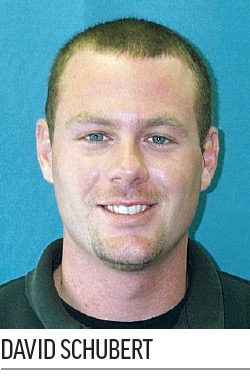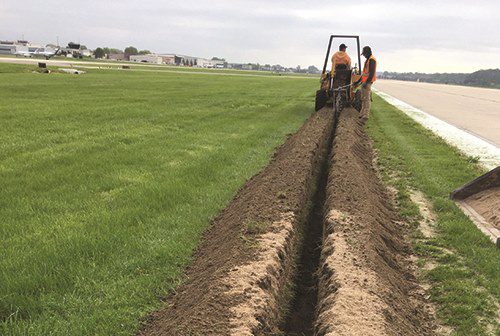The airfield at Spirit of St. Louis (SUS) Airport is safer and brighter following a $1.34 million project that overhauled its main runway with freshly renovated concrete and upgraded lighting. Since Runway 8R-26L was already scheduled for pavement rehabilitation, SUS management figured it was an opportune time to upgrade the runway’s lighting, too.
The airfield at Spirit of St. Louis (SUS) Airport is safer and brighter following a $1.34 million project that overhauled its main runway with freshly renovated concrete and upgraded lighting.
 “Both systems were in need of some attention, and this runway is our bread and butter,” says Deputy Director of Aviation Dave Schubert.
“Both systems were in need of some attention, and this runway is our bread and butter,” says Deputy Director of Aviation Dave Schubert.
Since Runway 8R-26L was already scheduled for pavement rehabilitation, SUS management figured it was an opportune time to upgrade the runway’s lighting, too. The south runway is considered the airport’s main runway for landings and departures, because its shorter north runway, 8L-26R, has operational restrictions in bad weather for corporate traffic.
|
Projects: New Runway Pavement & Lighting Location: Spirit of Saint Louis Airport Total Cost: $1.34 million
Funding: 90% FAA grant administered by Missouri Runway Length: 7,500 ft. Project Timeline: Planning & design 2018; construction March–June 2019 Design Engineer & Construction Manager: WSP-USA Main Contractor: Millstone Weber Concrete Joint Repair: 20,000 linear ft. Concrete Spall Repairs: 2,000 sq. ft. Airfield Lighting Manufacturer: ADB SAFEGATE High-Intensity Runway Lights: 98 Lighting Subcontractor: Reinhold Electric Lightning Protection: Bare Copper Counterpoise Lighting Cable in Conduit: 20,000 linear ft. |
Initially, SUS expected the lighting project to entail removing and replacing the existing light fixtures, which were a combination of stake-mounted units and base cans. But when the design process began, project engineers found that the fixture spacing was non-compliant and concerns also emerged about the age-related condition of existing in-ground circuits. Airport leaders consequently decided it was time for an entirely new system. In the end, contractors installed all-new lighting in concrete-encased bases with new cable and conduit, including new homeruns (the lighting circuit loop that runs from the runway back to the power supply in the electrical vault).
An FAA grant administered by the Aviation Section of the Missouri Department of Transportation covered 90% of costs for the lighting and pavement upgrades. The federal grant was much needed (and appreciated) by the county-owned airport because it is completely self-funded with traditional revenue sources such as fuel sales, hangar rentals and land leases.
Rob Heine, an airport engineer at SUS, explains that the FAA had strongly encouraged the airport to install new lighting on Runway 8R-26L due to its length. Throughout the years, the south runway has undergone a series of extensions and is now 7,500 feet. The previous direct-buried circuits and stake-mounted light fixtures required high levels of maintenance, where storms or electrical disruptions within the system would bring down 10 lights at a time, requiring emergency repairs.
In retrospect, Schubert and other airport personnel are glad they pressed on and completed both projects. The pavement work is designed to keep the runway performing safely until a full replacement can be performed sometime around 2029; and the new lighting system is also expected to last 20 years.
While making improvements on Runway 8R-26L, SUS took the opportunity to have the project team evaluate the rest of the airfield pavement, too. “This gave us a roadmap on what we need to do to the south runway over the next decade to keep it viable and prolong that full-depth reconstruction,” Schubert explains. Information gathered recently will also help support future grant requests.
New Incandescents
The decision to stick with quartz lighting entailed a lot of thought and debate. While cost-savings associated with LEDs were tempting, the project team felt that traditional incandescent lights are better suited to the airport’s temperate, but varied, climate.
“We’re right on that geographical line where the lights need heaters to handle the snow and ice load we get in winter,” Schubert explains.
In addition to tapping the project engineers and contractors for input, Schubert solicited opinions from other directors at predominantly corporate airports, and they were split right down the middle.
Although the team ultimately opted for quartz runway lights, the airport has LEDs on its taxiways. Because 8R-26L is a precision-approach runway, it has a five-step approach for lighting intensity.
Safety and reliability were major considerations as well. Jennifer Kuchinski, senior project manager at WSP, explains that lightning strikes and high water tables are prevalent at SUS, and the old lighting system regularly suffered shorts and outages. “Maintenance knew to be leery of working on the line due to shocks,” she comments. “With this new lighting system, they will not need to worry about the circuit’s integrity and reliability.”
In addition to providing better visibility for pilots, the upgraded runway lights will streamline maintenance for the airport. “While the maintenance staff kept the [previous] system working with impressive regularity, maintaining the circuit became an increasingly laborious task over time,” notes Kuchinski. “The new system will allow the maintenance staff to balance their efforts toward other airfield facilities and maintaining a world-class business/reliever airport for the community.”
Ben Sanchez, project manager with primary contractor Millstone Weber, reports that the project was fairly simple to execute. “Once the ball got rolling it was just keeping it going day after day until the scope was complete,” he says.
Reinhold Electric executed the lighting system upgrades, working as a subcontractor to Millstone Weber.

Innovation on the Fly
Keeping the runway open while contractors installed the new lighting system was a high priority, but as-built drawings revealed that the existing circuit was positioned right in line with the new light fixtures. This would present the safety risk of workers cutting into the existing circuit and would have caused delays, increased costs, as well as extended circuit outages. During design there was no opportunity to trace out the entire circuit, so the design team played it safe.
“We designed a complete temporary circuitry system on-grade to keep all the lighting energized while the new system was installed almost right on top of the old cable,” explains Robert Roseman, the electrical engineer of record from WSP. “This proved to be a challenge to detail the temporary cable connections to existing lights, some of which were in-pavement at taxiway connectors. In addition, we designed in savings by incorporating re-use of 24 existing displaced threshold and end light base cans, which were in the proper locations and in good condition.”

However, once in construction, as the contractor performed the required cable locating and marking, the existing cable was found to be routed just outside of the proposed new light locations. Consequently, the project team huddled to devise another way, and the contractor proposed a temporary jumper concept. Roseman notes that these issues affected the team’s decision not to install a full temporary circuitry system. “Until then, we kicked back and forth ideas of how much time the airport wanted to have the runway out of commission, just due to lighting versus the installation cost of the temporary system,” he relates. Ultimately, the team decided to execute the contractor’s proposal.
Each day after work was complete, crews used a series of jumper cables to tie the old lights into the new circuit so all runway lighting was operational. “The biggest risk to that, is that when you tie in new and old lights you can encounter high impedance, shorting out the ground,” Heine explains.
Fortunately, the jumper cable plan worked without a hitch.
Kuchinski also highlights the way contractors and WSP’s field team worked with the airport maintenance manager to map out the existing circuitry and utility locations as accurately as possible. This largely helped crews avoid inadvertently cutting into active lines. Kuchinski notes that the few times that did happen, the team worked together to identify the exact location of the cut so workers could perform a permanent repair to restore service quickly.
The team’s combination of preventive and on-the-spot fixes saved time and money. “That was the goal,” says Roseman. “The savings from not using the full temporary circuit allowed additional pavement repairs to be made.”
Heine notes that it was a “big moment” when the team realized it didn’t need to install an entire temporary lighting system.
Learning Along the Way
Ultimately, construction began in March 2019, the runway closed for two weeks in May, and the project was finished by late June. “The schedule gave the contractor time to get their feet wet, get used to the phasing,” Roseman recalls. “[It also] gave the airport time to become familiar with the scope of the project and perform cable locates and make the decision to go with jumper cables.”
The airport was able to use its existing lighting controls, but needed to install a new constant current regulator and 3,000 feet of home run to the electrical vault. “Think of it as Christmas tree lighting,” Heine explains.
Team members highlight phasing and communication as crucial to the project’s smooth success. Many specifically emphasize the value of explaining the construction process to airport tenants, soliciting their input, working collaboratively with contractors and designers and regular progress meetings.
“Schedule constraints were the biggest challenges,” Sanchez reflects. “Having to open the runway daily to operational criteria had to be accounted for in production projections.”

Roseman reminds other airports considering similar projects to loop in their maintenance staff. “It’s important to talk with the people who actually maintain the lighting and electrical systems,” he explains. “As-builts can only show you so much, but if you walk the site, they can point out locations of underground infrastructures, etc.”
In retrospect, Heine says that it was important to upgrade the runway’s lighting system, given the spacing issues, maintenance challenges and other ongoing concerns. “We accomplished it, and it proved worthwhile to add in the extra cost,” he says.
Schubert agrees. Most years, 200 to 250 aircraft fly in and out of SUS on a busy day; but flight operations have slowed 30% to 50% during the coronavirus pandemic. Even with traffic down, he reports that everyone is appreciating the newly lit, freshly paved runway.


 facts&figures
facts&figures

